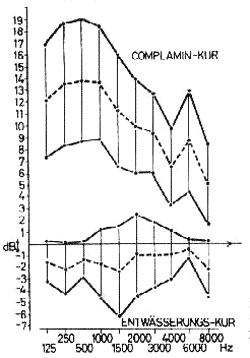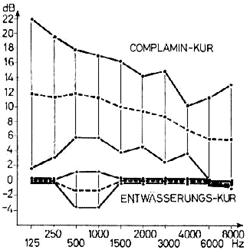

Vasodilatoric Therapy of Morbus Menière
Autor(es): Wolfgang Bader *
![]()
As you know Menière's disease is characterized by suddenly occuring attacks of vertigo with spontaneous nystagmus which in the beginning of the attack is mostly directed towards the affected ear, shortly afterwards, however, to the opposite side. Furthermore we find a one-sided hearing deficiency which is írreversible in the later phase of the disease. During the attack the massiv feeling of subjective vertigo is frequently accompanied by vomiting and pressure in the affected ear.
Recently this aspect of the disease has been attributed almost exclusively to an intra-labyrinthine increase of pressure, the pathologic-anatomic substrat of which is said to be the endolymphatic hydrops. But this conception cannot statistically be verified by the 23 cases collected in the literature by WUSTROW and the case reported by BUSANY-CASPARI and MATZKER. The analysis of these cases shows the following results: out of 19 Menière's diseases 8 are without hydrops, and out of 16 hydropses only 11 had a Morbus Menière. The examination of the 95% realiability range shows a 1:1 distribution (binomial distribution). Accordingly a Menière's disease is not necessarily connected with a hydrops. In this context it has to be mentioned that it was WITTMAACK himself, to whow we owe the terminus "Hydrops labyrinthi", who expressed strong doubs about a hydropíc genesís of the Menière's disease. A medicamentous therapy of this disease, based on the hydrops theory thus should normally be dehydrating.
Now I want to demonstrate to you 26 Menière - cases clinically and audiologically completely examined which have otherwise not especially been selected. They all Nave been treated for 14 days with high-percentage glucose solution and dehydrating medicaments. As standard for the judgement of success or failure of the therapy the audition-curve of each patient has been applied, since here an increase or decrease of audition is easíest indicated while the electronystagmography is less apt for this purpose (Fig. 1). In most of the 26 cases the audition remained unaffected or decreased. Computing the average figures of the single frequencies including the standard deviations it shows that after the dehydrating treatment the average figures run in the negative range, and that the top figures of the double standard deviation hardly exceeds the zero line. This results has been subjectively confirmed by the patients: most of them stated an aggravation of their general condition especially the increased giddiness and the irritability. The frequency of the attacks of subjective vertigo and their duration in most cases remained unchanged, also the intra-auditory seunds and the sensation of pressure.
Which conclusions can be deducted now from this results?
1 . Either this therapy does not effect the endolymphatic hydrops, or
2. the hydrops is not the only cause of the Morbus Menière.
Considering the obvious uselessnes of the dehydrating therapy a vasodilatoric treatment, too, has poor chances for success. Especially as this method of treatment has not necessarily as basis the argument of a hydrops labyrinthine. Thís therapy has been carried out with Complamin (Xanthenol - Nicotinat. Fa. J. A. Vülfing, Düsseldorf, w.-Germany) which is especially apt for these cases. In 500 ml physiological common salt solution as carrier substance 4,5 - 6g were dissolved and slowly infunded for about 3 - 4 hours.
What are the results now of a second group of 29 patients who had been subjected to this treatment of vasodilatoric infusions (Fig. I). Computing the average figures for the single frequencies of the audiogram including the according standard deviations a clear effect can be seen: the average figures below 3000 Hz all run very far in the positiv range. Their decrease in the higher frequencies is distinct but by far not as strong as to lad the lower limit of the double standard deviation ínto the negativ range.FIG. I - Change of auditory threshold after dehydrating therapy (= Entwässerungskur) and vasodilatorie therapy (= Complamin-Kur). Sample mean (= interrupted line) ; Double standard deviation (= drawn line).
When you compare now this limit with the curve of the upper limit of the double standard deviation of the patients who only nave been treated with the dehydrating method, you will see that both lines neither touch nor overlap in any frequency range. By this already the superiority of the vasodilatoríc therapy to the dehydrating has been proved.
The best proof, however, for the efficacy of the therapy of vasodilatoric infusion you will find with a third, relatively small group of 8 patients who first have been treated with the dehydrating therapy - and after an average period of these years - with the vasodilatoric therapy (Fig. II).FIG. II - Change of auditory threshold afted dehydrating therapy in the salve patients. Sample mean (= interrupted line) ; Double standard deviation (= drawn line).
Here you can see again the average figures and the according standard deviations of the curve of the threshhold of audition. The lower line shows the condition after the dehydrating treatment only which is unchanged for all persons or even has worsened. The upper curve shows the condition of tine patíent after the treatment of vasodilatoric ínfusion, which had been conducted about 3 years after the dehydrating treatment. Most curves of the threshhold of audition have approximately been improved about 10 to 20 dB.
The increasing of audition of this third group most clearly shows the superiority of the treatment of vasodilatoric infusions. To this the subjective statements of the patients about their condition after this therapy have to be acided. On the contrary to the dehydrating method, it is important here to state, that the subjective general condition of no patient has grown in any way. More than half of the patíents have hadnno attacks during the period of observation.
Frequency and duration of attacks of another 23% was reducted. The intra-auditory sounds, otherwise very difficult to influente, could be mitigated for one third of the patients.
Based on this therapy it furthermore has turned out that in about 50% of the cases Menière attacks can be stopped with a dose of about 0,2 to 0,4 mg of nitroglycerine. lt is very important to take this medicament at the first prodromi of the attack. As soon as vomiting has begun it is effectiveless. A great number of my patients who have been heaviest attacks succeeded in suppressing these attacks with nitroglycerine only, similar to those of stenocardia.
Based on these favourable results, 1 think I can recommend this new method of treatment of the Morbus Menière. This therapy gives any Morbus Menière, no matter how long it has existed, a statistically secured chance for improvement as long as it is still active; that means as long a the attacks of vertigo still appear. I have to point to the fact that this therapy demands some patince both from the patient and the doctor, who should not be riscouraged by some attacks of the Menière's disease during the first days of the infusion therapy.
In any case ove should try this therapy before one determines on one of the expensive surgical methods whoch, eliminating the labyrinthe, always conpatient tain the danger of a, for the patient very unpleasant, Dandy-sympton.
References
Aschon, Q.; J. Stalde: "Nystagmus in Menière's Disease during Attacks. Acta Otolaryngologica" 47 (1957) .189.
Altmann, F.: "Morbus Menière", Fortschr. Hals- Nas. - u. Ohrenheilk. 2 (1955) 1.
Beirkert, P.: "Disknssion zur Ätiologie und Pathogenese des Borbus Menière", Z. Laryng. Rhinol. 41 (1962) 828.
Hallipike, C. S.; H. Caims: "Observation on the pathology of Menière's syndrome, J. Laryng. 53 (1938) 625.
Jordan, R. E.: Round Table, "Surgery for Hydrops" Arch. Otolaryng. 89 (1969) 117.
Meyer zun Gottesberge, A.: Menière'sche Krankheit, HNO-Heilkunde-Handbuch, Bd. 111:2 1661 Thieme, Stuttgart 1966.
Mittemaier, R.: Über die Menière'sche Krankheit, HNO (Berl.) 7 (1959) 225. Schuknecht, H. F., Further Observations on the pathology ot Menière's disease. Ann. otol. (St. Louis) 71 (1962) 1039.
Windirisch, 0.: Menière und Stenokardien. Mschr. Ohrenheilk. 87 (1955) 13.
Wittmaack, K.: Die Meninre'sche Krankheit in, Lichte der Tonuslebre. Arch. Ohr.-, Nas. - u. Kehlk.-Heilk. 124 (1930) 177.
Wustrov, F. w. B. Borkonsky: Ergebnisse nach, konservativen und chirurgischer, Behandlunkmethoden sowie kritische Betrachtungen zur Pathogenese des Borb. Menière, z. Laryng. Rhinol, 39 (1960) 113.
* Friedberg - Alemanha.
All rights reserved - 1933 /
2025
© - Associação Brasileira de Otorrinolaringologia e Cirurgia Cérvico Facial

